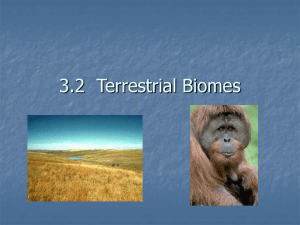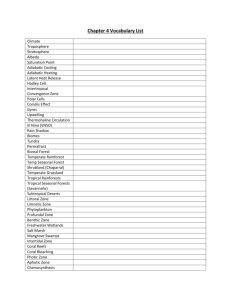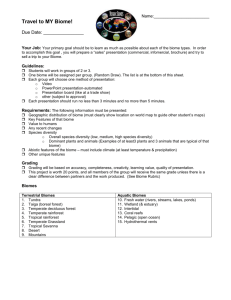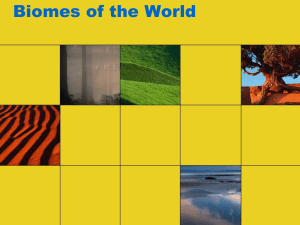File
advertisement
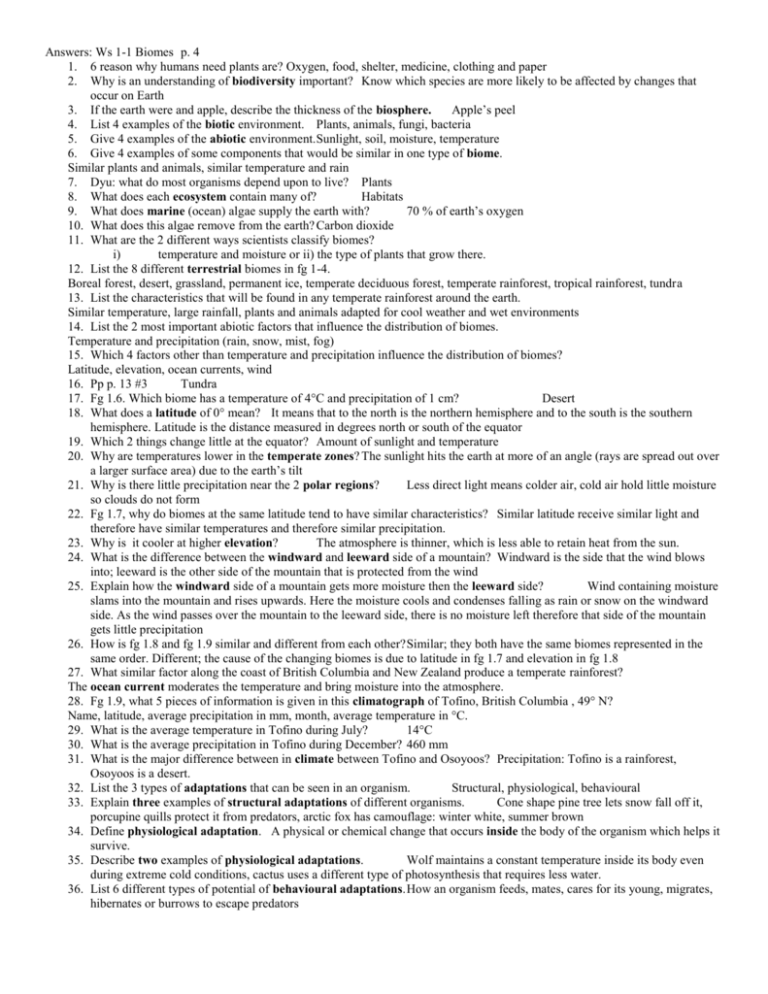
Answers: Ws 1-1 Biomes p. 4 1. 6 reason why humans need plants are? Oxygen, food, shelter, medicine, clothing and paper 2. Why is an understanding of biodiversity important? Know which species are more likely to be affected by changes that occur on Earth 3. If the earth were and apple, describe the thickness of the biosphere. Apple’s peel 4. List 4 examples of the biotic environment. Plants, animals, fungi, bacteria 5. Give 4 examples of the abiotic environment. Sunlight, soil, moisture, temperature 6. Give 4 examples of some components that would be similar in one type of biome. Similar plants and animals, similar temperature and rain 7. Dyu: what do most organisms depend upon to live? Plants 8. What does each ecosystem contain many of? Habitats 9. What does marine (ocean) algae supply the earth with? 70 % of earth’s oxygen 10. What does this algae remove from the earth? Carbon dioxide 11. What are the 2 different ways scientists classify biomes? i) temperature and moisture or ii) the type of plants that grow there. 12. List the 8 different terrestrial biomes in fg 1-4. Boreal forest, desert, grassland, permanent ice, temperate deciduous forest, temperate rainforest, tropical rainforest, tundra 13. List the characteristics that will be found in any temperate rainforest around the earth. Similar temperature, large rainfall, plants and animals adapted for cool weather and wet environments 14. List the 2 most important abiotic factors that influence the distribution of biomes. Temperature and precipitation (rain, snow, mist, fog) 15. Which 4 factors other than temperature and precipitation influence the distribution of biomes? Latitude, elevation, ocean currents, wind 16. Pp p. 13 #3 Tundra 17. Fg 1.6. Which biome has a temperature of 4°C and precipitation of 1 cm? Desert 18. What does a latitude of 0° mean? It means that to the north is the northern hemisphere and to the south is the southern hemisphere. Latitude is the distance measured in degrees north or south of the equator 19. Which 2 things change little at the equator? Amount of sunlight and temperature 20. Why are temperatures lower in the temperate zones? The sunlight hits the earth at more of an angle (rays are spread out over a larger surface area) due to the earth’s tilt 21. Why is there little precipitation near the 2 polar regions? Less direct light means colder air, cold air hold little moisture so clouds do not form 22. Fg 1.7, why do biomes at the same latitude tend to have similar characteristics? Similar latitude receive similar light and therefore have similar temperatures and therefore similar precipitation. 23. Why is it cooler at higher elevation? The atmosphere is thinner, which is less able to retain heat from the sun. 24. What is the difference between the windward and leeward side of a mountain? Windward is the side that the wind blows into; leeward is the other side of the mountain that is protected from the wind 25. Explain how the windward side of a mountain gets more moisture then the leeward side? Wind containing moisture slams into the mountain and rises upwards. Here the moisture cools and condenses falling as rain or snow on the windward side. As the wind passes over the mountain to the leeward side, there is no moisture left therefore that side of the mountain gets little precipitation 26. How is fg 1.8 and fg 1.9 similar and different from each other? Similar; they both have the same biomes represented in the same order. Different; the cause of the changing biomes is due to latitude in fg 1.7 and elevation in fg 1.8 27. What similar factor along the coast of British Columbia and New Zealand produce a temperate rainforest? The ocean current moderates the temperature and bring moisture into the atmosphere. 28. Fg 1.9, what 5 pieces of information is given in this climatograph of Tofino, British Columbia , 49° N? Name, latitude, average precipitation in mm, month, average temperature in °C. 29. What is the average temperature in Tofino during July? 14°C 30. What is the average precipitation in Tofino during December? 460 mm 31. What is the major difference between in climate between Tofino and Osoyoos? Precipitation: Tofino is a rainforest, Osoyoos is a desert. 32. List the 3 types of adaptations that can be seen in an organism. Structural, physiological, behavioural 33. Explain three examples of structural adaptations of different organisms. Cone shape pine tree lets snow fall off it, porcupine quills protect it from predators, arctic fox has camouflage: winter white, summer brown 34. Define physiological adaptation. A physical or chemical change that occurs inside the body of the organism which helps it survive. 35. Describe two examples of physiological adaptations. Wolf maintains a constant temperature inside its body even during extreme cold conditions, cactus uses a different type of photosynthesis that requires less water. 36. List 6 different types of potential of behavioural adaptations. How an organism feeds, mates, cares for its young, migrates, hibernates or burrows to escape predators 37. Describe 3 behavioural adaptations of the burrowing owl. Puts grass in front of burrow which moderates the temperature inside, puts cow crap at the entrance of the burrow to hide the scent of itself and its babies, makes hissing sounds inside the burrow to simulate the poisonous rattlesnake. Answers Ws 1-2 Ecosystems p. 34 1. List 3 long-term effects of human activities and 2 natural events on the forest that researchers try to study. Human: livestock grazing, fire suppression, and timber harvesting natural events drought and disease 2. WC; Define ecology. Study of the interactions of organisms and their environments 3. What are biomes split into? ecosystems 4. List at least 7 of the abiotic and biotic components of an ecosystem. Abiotic: oxygen, water, nutrients, light, soil biotic: plants animals, micro-organisms 5. Give 2 examples of tiny ecosystems. Rotting log or a tidepool 6. Define habitat. The place where an organism lives 7. Fg 1.19 shows? Gasoline or oil leaking into aquatic environment killing the plants that produce oxygen and food for the animals 8. Why do you sometimes see fish at the surface gulping for air? The plant life in the wetland has been damaged and is not producing enough oxygen for the aquatic animals 9. Why is there so few plants in fig 1.20? The deeper you go in water, the less light penetrates from the sun. Plants need light to live. 10. Fg 1.21. Which part of a forest receives the most light? The canopy. 11. What does soil provide? Nutrients for plants and supports many species of small organisms 12. 1m2 supports up to how many invertebrate species? 1000 13. 1 g of soil supports how many different types of bacteria? Few thousand. 14. Why are earthworms important? Dig tunnels in the soil which allow water, nutrients and oxygen to move through the soil. They also breakdown dead materials (detritus) and return the nutrients back to the soil for other plants to re-use. 15. Why are soil bacteria and ground beetles important? Soil bacteria break down pollutants ground beetles store carbon by eating insects 16. Think: why is cement and pavement considered to be a death zone? Cement and pavement are basically death zones because they can not sustain any plant life and therefore any other type of life 17. Define species and give an example. Group of organisms that can reproduce with each other ex; black bear 18. Define population and give an example Members of one species within a certain defined area. Ex: the population of Windermere. 19. Define community and give an example. All the populations of different species that interact in a specific area or ecosystems. Ex: fg 1.24 p. 39 eagles, grizzly bears, salmon, fir trees, cotton wood trees etc 20. Define symbiosis. Interaction between members of two different species that live together in a close association 21. Define commensalism. sybiotic relationships in which 1 species benefits and the other species is neither helped nor harmed. 22. What does the sea anemone get from the commensalistic relationship in fg 1.25? nothing. 23. What does the humpback whale get from this relationship in fg 1.26? Nothing. 24. How is fg. 1.27 an example of commensalism? The Spanish moss live high up on the tree and gets more light, moisture, and nutrients. The tree gets nothing? 25. Define mutualism and give an example from fg. 1.28. Both organisms benefit. The bumblebee collects pollen (food) from the snapdragon and the snapdragon gets pollinated (the egg is fertilized by a sperm from an other plant) 26. Explain the mutualistic relationship between the squirrel and the trees. Underground fungus helps trees live, squires eat fungus, squirrels crap out fungus spores (seeds) on the forest floor so that seedlings (baby trees) can germinate and grow. 27. Explain fg 1.3. Ants feed from the nectar inside leaves of the tree, ants protect tree from other animals or insects that want to eat the tree 28. Fg 1.31. What does the fungus provide to the alga? Carbon dioxide and water for photosynthesis, minerals, protection from dehydration (water loss) 29. What does not usually happen during parasitism? The host is not killed. 30. Fg. 1.32. How does a dog become infected with Ancylosoma caninum? Exposure to soil or feces. 31. Fg. 1.33. how does the Rafflesia arnoldii live? Filaments grow into the tetrastigma vine where it sucks out nutrients. 32. Define niche. An organism’s “job” in the environment. The way in which it contributes to and fits into the environment 33. Fg 1.34. How can the great blue heron occupy a different niche as compared to other species of heron? Great blue heron has longer legs and can therefore feed for fish in deeper water then other species of heron 34. Define competition. A harmful interaction between 2 or more organisms that can occur when organisms compete for the same resource in the same location at the same time. 35. How can competition limit the size of a population? The organism expends so much energy competing against other organisms that its health and ability to grow and reproduce is reduced. 36. Fg. 1.35. how does the spotted knapweed reduce its competition? Releases chemicals into the soil which prevents the growth of other plants around it. 37. Fg. 1.36. Why are the coyotes fighting when they often hunt in packs? Food sources are much smaller, only able to feed one individual. They therefore are competing for the limited small prey (food) 38. List 4 examples of prey adaptations. Turtles and clams have hard shells, newts produce poisonous substances, porcupine have spines, stick bugs use camouflage (look like sticks), viceroy butter fly uses mimicry (looks like a poisonous monarch butterfly) 39. Fg. 1.41, in the predator-prey relationship graph why do the numbers of lynx and snowshoe hares go up and down? Lots of lynx eat the hares → few hares, lynx then starve; few lynx eat hares → lots of hares → lots of lynx 40. What are some other important ways prey populations are regulated by factors other than predation. Availability of food, space, rate of population growth 41. Define biodiversity The variety of species in a given area 42. What does a large biodiversity often indicate? The health of the ecosystem 43. Fg 1.43. What do parking lots provide that wetlands do not? More places to park cars 44. What is the most common cause of biodiversity loss? Habitat loss 45. What is the greatest threat to ecosystems in British Columbia? Expansion of cities due to TOO MANY PEOPLE CHAPTER 1 ANSWERS Reading Check Answers, p. 12 1. A biome is the largest division of the biosphere and includes large regions that have similar biotic and abiotic components. 2. The biotic components of a biome are the living morganisms including plants, animals, bacteria, protists, and fungi. 3. The abiotic components of a biome include temperature, amount of rainfall or precipitation, and soil. 4. Biomes found in Canada include the temperate rainforest, the boreal forest, the temperate deciduous forest, grasslands, and tundra. Reading Check Answers, p. 15 1. Two abiotic factors that influence the characteristics of biomes are latitude and elevation. 2. Temperature changes with latitude because the higher the latitude the less intense the Sun’s rays so the temperature is lower in regions farther from the equator. 3. Precipitation changes with latitude because at the equator the moist air quickly rises, cools, and falls back to Earth as rain. In the north at high latitudes, little moisture rises so little moisture falls. 4. The temperate rainforest biome can be located in two very different parts of the world if the locations are at the same latitude, which affects temperature and precipitation. 5. You may find different biomes on a mountain because elevation affects temperature and the amount of precipitation and both these factors affect the type of biome. Reading Check Answers, p. 19 1. An adaptation is a characteristic of the organism that enables the organism to better survive and reproduce. 2. Three types of adaptations are structural adaptations, behavioural adaptations, and physiological adaptations. 3. Adaptations that benefit animals include sharp, stiff quills for defence, thick white coats for winter warmth and camouflage, and the ability to maintain a constant internal body temperature. 4. An adaptation that benefits plants includes different photosynthetic processes for cacti compared to plants from temperate regions. Reading Check Answers, p. 25 1. Three characteristics of the tundra biome are low annual precipitation, cold winters averaging -32°C, and permafrost. 2. Two characteristics of the boreal forest biome are 30 to 85 cm of annual precipitation mainly as snow, temperatures below freezing for half the year, and a short summer growing season. 3. In a temperate rainforest, the trees can grow very tall and include large evergreens such as the Sitka spruce and Douglas fir. Mosses are draped on trees, and lichens cling to tree trunks. 4. Temperate and tropical 5. Grassland plants can survive drought and prairie fires because they have well-developed root systems. CYU 1.1 p.33 1. The biosphere is the thin layer of air, land, and water on or near Earth’s surface in which all living things on Earth exist. 2. Any three non-living parts of the environment, such as sunlight, soil, moisture, and temperature. 3. The factors that influence the characteristics and distribution of life in a terrestrial biome include temperature, precipitation, latitude, elevation, and ocean currents. 4. The importance of adaptations to the survival of plants and animals in their biome is that adaptations enable organisms to better survive and reproduce. 5. Plants are adapted to survive a short growing season by growing quickly during the long, sunlit summer days. 6. Sample answer: Two boreal forest animals are chipmunks, which burrow in winter, and mammals such as moose, which have thick insulating coats. 7. Temperate rainforest biomes are found along coastlines because ocean winds drop large amounts of moisture on the windward side of the mountains. 8. Little vegetation is found on the floor of the tropical rainforest because the soil is poor as nutrients are quickly recycled, heavy rain washes minerals away, and little light reaches the forest floor. 9. (a) Climatograph A represents the desert biome. Climatograph B represents the cold desert biome. (b) To identify the biome, look for a Climatograph of similar patterns or obtain the information off the graph for average temperatures and precipitation and compare that to available biome data. 10. (i) Tundra (b) permafrost (ii) Boreal forest (g) coniferous forest (iii)Temperate deciduous forest (d) many layers of trees and plants, but light gets through (iv) Grasslands (a) distinct seasons, moderate climate (v) Tropical rainforest (e) great biodiversity, many layers of trees and plants, but light does not get through (vi) Desert (f) fleshy, spiny cacti (vii)Temperate rainforest (c) Douglas fir, moss, Lichen 11. Latitude influences temperature and precipitation since the zone between the Tropic of Cancer and the Tropic of Capricorn, called the tropical zone, receives more direct sunlight and has warm temperatures. In the tropics, the direct sunlight heats moist air, which quickly rises, then cools in the upper atmosphere and falls back to Earth as rain. These patterns decrease the farther away from the equator you are. 12. Temperature affects the biotic component of biomes because temperature affects the amount of precipitation that falls. Organisms must also be adapted to extreme heat or cold. 13. Plants and animals of eastern Canada are similar to the plants and animals of eastern Asia because they are found in similar latitudes so they have similar climates. 14. The three types of adaptations are structural, physiological, and behavioural. An example of a structural adaptation is thick fur for winter. An example of a physiological adaptation is the ability to maintain a constant internal temperature. An example of a behavioural adaptation is hibernation to escape winter cold. Accept all reasonable answers. 15. (a) Travelling directly north from Venezuela near the equator to the North Pole, the terrestrial biomes that you would travel through include: grassland, tropical rainforest, temperate deciduous forest, boreal forest, and tundra. (b) Sample answer: Biome Animals Plants Grassland antelope, wolves grasses Tropical rainforest parrots, toucans, sloths vines, orchids Temperate deciduous forest squirrels, cougars, deer maple, birch, and oak trees Boreal forest moose, snowshoe hares Coniferous trees Tundra Arctic foxes and hares, caribou short grasses, lichens, & mosses Reading Check Answers, p. 38 1. An ecosystem is a subdivision of a biome. 2. A habitat is the place where an organism lives. 3. Abiotic components of ecosystems necessary to support life are oxygen, light, soil, water, and nutrients. 4. Soil is important to ecosystems because it provides nutrients, supports many species of small organisms, and anchors plants. Reading Check Answers, p. 39 1. A species is a group of closely related organisms that have the same structure and can reproduce with one another. 2. A population is all the members of a particular species within an ecosystem. 3. A community is all the populations of the different plant and animal species within a community. The community also includes the populations of fungi and micro-organisms. Reading Check Answers, p. 44 1. Symbiosis is the interactions between members of two different species that live together in close association. 2. Commensalism is a symbiotic relationship in which one species benefits and the other species is not helped or harmed. 3. An example of mutualism is the relationships between certain flowering plants and bee, wasp, or bat species in pollination. Students may also use the relationship between the fungus and the squirrel or the ant living on the acacia bush. 4. Examples of parasitism are worms within humans and dogs or the mountain pine beetle attacking pine trees. Reading Check Answers, p. 47 1. A niche is the role the organism has in the ecosystem, which includes the way the organism contributes to and fits into its environment. 2. The resources that organisms compete for include food, habitat, and space. 3. Predation is an interaction where one organism (the predator) eats all or part of another organism (the prey). 4. Sample answer: One example of a predator is a lynx. 5. Any two of the following (other answers may be acceptable): Ways in which prey avoid predators include having sharp spines like the porcupine or hard shells like the clam or turtle. Some prey produce poisonous or distasteful chemicals. Others use camouflage. CYU 1.2 p.51 1. The terms from smallest to largest are single species, population, community, ecosystem, biome, and biosphere. 2. A habitat is where the organism lives and a niche is what role the organism plays in the environment. 3. A – biome; B – ecosystem; C – habitat 4. Ecosystems provide water, light, nutrients, oxygen, and soil. 5. Soil is important for terrestrial ecosystems because it provides nutrients, supports many species of small organisms, and anchors plants. 6. Some organisms in an ecosystem are in competition for food or habitat when they occupy the same area at the same time. 7. (a) Sample answers: An example of plant adaptation for mutualism is the snapdragon colours to attract bees. An example of an animal adaptation for mutualism is that bees transport pollen on their hairs when obtaining nectar. (b) Sample answers: An example of a plant adaptation in predation is spines on a cactus. An example of an animal adaptation in predation is highly developed senses, such as good eyesight and an acute sense of smell. 8. (a) Mutualism (b) Commensalism (c) Parasitism (d) Competition (e) Mutualism 9. Sample answer: Ecosystems are important to the survival of humans because they provide food, water, nutrients, timber, and medicine; purify water; and prevent flooding. 10. Students’ answers will vary but may include: (a) two trees competing for the same soil nutrients (b) robin eating an earthworm (c) sparrow’s nest in a tree (d) squirrel collecting and burying acorns 11. Plants are not defenceless because they can release chemicals to prevent other plants from growing or prevent animals from eating them. Others, like cacti, have spines for protection. 12. If two species compete for the same resources, the health of both organisms and their ability to grow and reproduce will be reduced. 13. (a) When the number of prey animals is low, the predator number is low. (b) When the number of prey is high, the predator number is high if there is sufficient food for the prey. CHAPTER 1 REVIEW p.52 1. The relationship between the biosphere, a biome, and an ecosystem is that ecosystems make up biomes and biomes make up the biosphere. 2. (a) Three factors that influence the characteristics of biomes are temperature, precipitation, and elevation. Students may also list latitude, ocean currents, and soil. (b) Warmer temperatures and more rainfall exist closer to the equator. Temperature drops with increasing elevation. There is more precipitation on the windward side of mountains. Accept all reasonable answers. 3. The two factors that are the most important for determining a region’s climate are temperature and precipitation. 4. A climatograph is a graph of climate data for a specific region based on data for many years and includes precipitation and temperature data. 5. Adaptations are characteristics that enable organisms to better survive and reproduce. 6. The difference between a structural adaptation and a behavioural adaptation is that a structural adaptation is a physical feature of the organism that contributes to the survival of the organism. For example, the Arctic fox has thick fur. A behavioural adaptation is what the organism does to survive unique conditions. For example, bears hibernate in winter to withstand the cold. 7. Temperate rainforest biomes are usually found along the coasts of continents because mountain ranges are often found near coastlines and the ocean winds drop moisture on the windward sides of mountains. 8. There are few trees in the grassland biome because fire and grazing kill seedlings and rainfall is limited. 9. Temperature decreases with elevation, and precipitation is higher on the windward side of the mountain. The leeward side receives much less precipitation. 10. At the top of a mountain, you may find a polar ice, tundra, or boreal forest biome depending on the elevation. 11. Three abiotic components of an ecosystem are light availability, water availability, and nutrient availability. Light and water are required for photosynthesis. Water is required for chemical reactions to occur in plants and animals and to transport nutrients. Nutrients are required for plant growth. 12. Ecological hierarchy is the order of biotic interactions from organism to population to community to ecosystem. 13. In mutualism, both organisms benefit from the interaction. In commensalism, one organism benefits while the other organism does not benefit nor is it harmed. 14. In parasitism, one species benefits and the other is harmed but usually not killed. In predation, one organism benefits and the other organism is often killed as the predator eats all or part of the organism. 15. Prey animals have adaptations such as spines, hard shells, and camouflage or look like other harmful organisms to avoid being eaten. 16. If a plant were moved from a wetland to a desert, it would probably not survive because it would not have the right type of root system to absorb limited amounts of water. Also, the leaves would not be adapted for dry conditions and too much water would be lost through the leaves. 17. Biomes are often classified according to their plant species rather than by the animals that live in the biome because plants are established before the animals. Certain animals depend on particular plant species for their survival (food and habitat), so it is the plants that determine the animal life. 18. Hot desert ecosystems can exist on every continent on Earth except Antarctica because high temperatures and little rainfall exist at latitudes around 30° north and south. 19. Symbiotic relationships are part of an organism’s niche because these relationships describe the interactions with other plant and animal species in the ecosystem. 20. If the host is killed in a parasitic relationship, the parasite would die because it depends on the host as an energy and nutrient source. 21. Competition can affect the health of an organism and its ability to reproduce because energy is used to compete against other organisms. 22. The size of the prey population will grow when there are few predators and shrink when the predator population becomes higher. 23. 1-C boreal forest 2-A tropical rainforest 3-F grassland 4-G desert 5-D temperate deciduous forest 6-B temperate rainforest 7-E tundra 8-H permanent (polar) ice 24. (a) The symbiotic relationship between a marmot and raccoon is an example of commensalism. (b) The marmot is primarily a herbivore but since it occasionally eats insects it would be considered an omnivore.




